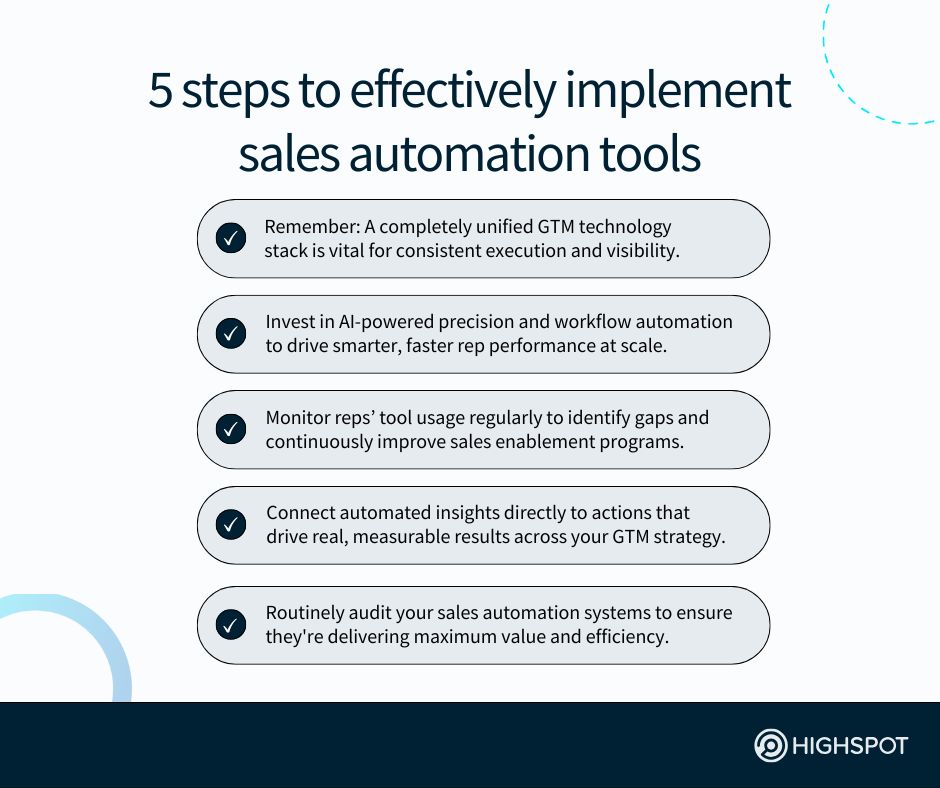Key Takeaways
- Sales automation is essential for go-to-market (GTM) teams, as it saves them time, improves consistency, increases rep productivity, and ensures buyers get faster, smarter, and more relevant engagement.
- Sales process automation empowers GTM leaders to connect tools, teams, and data, enabling smoother handoffs, faster execution, and real-time insights that drive better forecasting and decision-making.
- The best sales tools to automate repetitive tasks remove friction from seller workflows, streamline enablement content delivery, and help reps focus on closing deals, not admin, busywork, or platform switching.
If your B2B sales team is like those at countless other companies today, you know the number of repetitive sales tasks on your reps’ plate is unsustainable.
They spend a good chunk of their days toggling between disconnected tools, piecing together sales workflows, conducting manual data entry in various systems, and—ultimately—wasting time that should be spent selling.
That’s where the new era of sales automation comes in: smarter, more strategic, and seamlessly embedded into how your go-to-market (GTM) team actually works.
What is sales automation?
Sales automation software tackles several manual, repetitive tasks for sales reps so they can focus on selling and tracking deal progress, not manually updating CRM fields or building custom presentations and messaging for prospects.
Sales automation technology takes care of administrative tasks like data entry and lead routing and aids with outreach efforts such as sending sales email follow-ups.
It exists to help sales teams focus on closing deals, not time-consuming tasks like back-office work or developing personalized content and pitches for leads.
By automating sales processes, reps save time, build consistency, scale faster, and lose fewer leads in the cracks. The best sales automation tools streamline workflows and boost sales productivity by keeping sales reps in their groove, allowing them to shine by giving them more time, less chaos, and smarter support.
| Task handled by sales automation | How this helps B2B sales teams |
|---|---|
| Auto-logging CRM activity | – Saves reps hours each week on manual input – Keeps data clean for accurate forecasting – Reduces admin drag during busy deal cycles |
| Lead routing and assignment | – Gets hot leads to the right rep instantly – Speeds time-to-first-touch and conversion – Prevents leads from falling through gaps |
| Prospect meeting scheduling | – Eliminates back-and-forth coordination – Shortens sales cycles with faster bookings – Improves prospect experience with less friction |
| Follow-up email sequences | – Keeps prospects warm without manual effort – Ensures consistent sales outreach at scale – Frees reps to focus on strategic conversations |
| Opportunity stage progression | – Moves deals through pipeline automatically – Improves pipeline hygiene without extra clicks – Supports accurate stage-based forecasting |
| Proposal and quote generation | – Reduces time on repetitive document tasks – Ensures pricing accuracy/brand consistency – Accelerates sales cycles and deal turnaround |
| Lead enrichment and data cleanup | – Provides reps with better lead context up front – Cuts time wasted researching prospects – Improves prospect targeting with cleaner data |
| Sales play surfacing in CRM | – Delivers just-in-time guidance in real workflows – Drives adoption of strategic GTM initiatives – Helps reps act faster with less guesswork |
| Post-meeting follow-up automation | – Automatically recaps meetings and next steps – Keeps deals warm with consistent touchpoints – Ensures follow-up without manual tracking |
| Sales content recommendations | – Surfaces the best assets for each deal stage – Increases buyer engagement and conversion – Saves time hunting through content libraries |
Why sales automation is invaluable today
No sales process is complete without automation that meets reps where they are. And we don’t just mean helping with daily sales task automation. We’re also talking about generating AI-powered selling insights that guide actions, personalize content, and help all sales team members move faster and with precision.
While marketing automation helps with lead generation and nurturing, sales automation drives what happens after the handoff. It’s your frontline’s rocket fuel.
But let’s be real: Many platforms promise speed and automation with AI—and underdeliver. The best ones automate critical actions, not create more noise. More to the point, leading sales automation streamlines rep workflows, delivers real-time sales intelligence, and helps scale what works, not guess at what might.
In 2026, a ‘great’ sales automation solution is one that is:
- Embedded in reps’ day-to-day workflows across CRM, email, mobile, and more
- Built to handle complex, multi-touch B2B sales processes on relative autopilot
- Powered by AI sales tech that’s trained on your best data—not someone else’s
- Unified with training, coaching, and enablement content (and eliminates siloes)
- Designed to reduce laborious, time-consuming tasks, not create more busywork
Like other B2B sales organizations, you’re chasing efficiency and consistency. But that only happens when automation is the backbone of your entire sales technology stack, not a bolted-on feature to a single point solution.
From onboarding new sales representatives to closing deals with high-value leads, the right sales automation systems make B2B sales teams like yours more—well—systematic in their account-based selling approach, because they automate what’s slowing you down and amplify what’s actually driving revenue.
The 5 biggest benefits of sales automation
“Not only does an overabundance of tools stymy workflows and block efficiencies, but having too many of them costs businesses productivity,” Highspot’s Essential Revenue Tech Stack Guide explains. “Your sellers spend valuable time during their day switching between platforms to find what they need instead of selling.”
The good news? With the right sales tools that connect directly and automate tasks not only for reps, but also your sales managers, marketers, enablement personnel, and revenue leaders, you don’t have to worry about ‘tech bloat’ negatively impacting your go-to-market strategy and business-growth aspirations.
In fact, this kind of integrated sales software ecosystem actually:
1) Reduces the number of manual tasks for sales professionals
No one got into sales to spend their day updating CRMs or logging call notes.
Sales automation takes those labor-intensive sales tasks off your plate and gives you back time to focus on what you do best: connecting with people and closing deals.
From auto-logging activity, to auto-creating follow-up emails, to auto-generating custom reports, sales automation covers all the basics for reps, giving them hours back each week they can then spend engaging qualified leads, building customer relationships, and getting more sales to the finish line.
2) Ensures newly qualified leads are put in front of reps ASAP
Speaking of qualified leads, sales automation ensures MQLs don’t just sit in a queue. Instead, they get routed instantly to the right rep at the right time—notably, when prospects’ CRM-generated lead scores indicate strong buying intent.
With automated workflows and smart lead scoring (as long as you have accurate data), each sales rep can jump in quickly, follow up, and start building pipeline.
That accelerated speed-to-first-contact, thanks to custom-tailored sales process automation that can be set up by your sales operations manager, is a major win, especially when you’re trying to engage qualified buyers before competitors.
3) Helps deliver timely and personalized customer interactions
‘Blended’ marketing and sales automation platforms makes your outreach feel less like a generic campaign blast and more like a well-timed, human touch specifically crafted for each active opportunity in your sales reps’ pipeline.
Whether it’s personalized sales email automation or follow-ups triggered by new buyer behavior and actions, sales automation lets you reach prospects with the more relevant, well-timed product messaging and brand collateral.
For instance, enablement tools, like Highspot, that track customer engagement can alert your reps when a lead revisits pricing content in a digital sales room so they can swoop in to see if they can answer any solution-related questions.
It’s AI-powered precision that helps sales teams like yours use updated customer data responsibly and effectively for targeted, timely buyer engagement.
4) Leads to continually increasing sales productivity for all reps
Your sales representatives can remain locked in on active opportunities by using sales automation platforms to erase distractions and surface next-best actions.
The most successful B2B sales teams rely on systems that fit effortlessly into their entire sales process and daily workflows to automate manual tasks and free up time, not solutions that force them to reconfigure the way they work.
Proven sales automation platforms help reps move faster, show up smarter, and close deals with confidence. Reps don’t bounce between tabs or dig for insights endlessly. Instead, they’re laser-focused on the leads in front of them.
Sales automation is how GTM teams become not just more productive and, collectively, make headway with business-critical goals tied to their sales strategy.
5) Syncs seamlessly with sales enablement and CRM software
More specifically, the top sales organizations are able to increase sales more consistently and predictable because of direct integrations between core sales software and AI-powered automation tools that simplify operations.
“Integrations connect various tools … to streamline workflows and improve the user experience,” per Highspot’s State of Sales Enablement Report 2025. “When coupled with AI, integrations eliminate the need for manual data entry and allow for immediate insights into how your go-to-market strategies are landing.”
Sales automation doesn’t live in a silo. It plays nice with other sales software.
Integration is everything. When your sales tools talk to each other, it’s magic:
- Content proven to move the needle with deal discussions appears when reps need it most. Think discovery sales calls and late-stage presentations.
- Sales data flows back and forth between your CRM and other GTM solutions. For instance, the Highspot-Salesforce integration makes it simple to see which leads are engaging with which assets in different sales funnel stages.
- Your sales manager gets the visibility they need to coach, plan, and optimize. They can have custom sales reports tied to rep performance, training progress, and initiative outcomes auto-generated and sent to their inboxes.
Automated workflows between your sales enablement and CRM system, in particular, mean fewer handoffs between GTM teams, less double entry, and way more impact.
It’s the glue that makes your revenue tech stack actually stack.
BONUS: Acts as a coaching assistant for B2B sales managers
This one’s for the sales leaders like you—those who want more time coaching and less time digging through data. Sales automation can act like a virtual assistant by surfacing trends, tracking deal risks, and even analyzing sales reps’ talk time and cadences on sales calls (even how often they speak versus leads talking).
All this leads to more impactful and potent AI sales coaching that, in the long run, can help each of your sales team members better manage their individual sales pipelines, meet quotas more consistently, and grow professionally.
“Sales coaching is experiencing a transformation thanks to AI,” according to Highspot’s Ultimate Guide to Coaching for Revenue Teams. “Look for every opportunity to streamline your coaching and feedback with AI and automation—from AI-generated meeting feedback to automated assessments.”

Implementing sales automation tools
The benefits of sales automation are evident.
What may be less clear is how your GTM leadership can work together to find and implement tools that automate repetitive tasks, strengthen customer relationship management, and—at the end of the day—contribute to better sales efficiency and revenue growth.
That’s where this five-step playbook comes in.
Step #1: Remember: A unified GTM technology stack is vital
Your go-to-market tech stack is meant to automate repetitive sales tasks for your sales reps, not add complexity. When systems don’t speak the same language, your data gets messy, insights get delayed, and execution gets clunky.
A unified tech stack ensures smooth sales pipeline management, clearer visibility into what’s working, and faster time to value for sales reps. Think of it as setting a strong foundation before building out your automation strategy.
Advice for researching sales automation tools on the market:
- Compare how each tool fits into your current GTM tech ecosystem
- Look for tools that support complex B2B sales processes end-to-end
- Prioritize platforms with real-world case studies and user reviews
- Ask vendors how they support integration and sales process alignment
- Ensure prospective sales process automation tools aren’t redundant
Step #2: Invest in AI-powered tools for workflow automation
Sales automation is your engine for scaling precision.
When your sales operations team ultimately invests in IT- and procurement-approved automation tools powered by native, purpose-built AI capabilities, your sales reps get guidance and content tailored to each of their sales pipelines.
It removes guesswork and helps each sales rep focus on the next best move. Whether they’re prospecting, qualifying, or closing deals, reps stay in flow and on task. That kind of workflow automation is efficient and transformative.
Tips to ensure you buy the best sales automation solutions:
- Choose tools that scale with your team—not just solve today’s pain
- Validate the quality of AI outputs and workflow automation logic
- Involve sales ops, enablement, and RevOps in the buying process
- Ensure it supports every stage of each sales rep’s daily workflow
- Clarify what onboarding, training, and post-sale support is included
Step #3: Monitor your tool usage to improve sales enablement
You can’t ‘set and forget’ your sales process automation platforms. Track how your reps engage with each tool weekly to tackle various sales tasks. Similarly, see which solutions are ‘sticking’ with reps and where drop-off happens.
Utilization data helps identify what parts of your sales process are working (read: removing repetitive tasks and speeding up sales cycles) and what needs to be rethought so your sales professionals get the desired value from the tech.
Best practices for boosting sales automation tool adoption:
- Train your team in context—within the tools they already use
- Celebrate quick wins to build momentum and internal champions
- Share usage analytics and outcomes during team meetings regularly
- Collect rep feedback early and often to fine-tune automation flow
- Make adoption part of performance reviews and team KPIs
Step #4: Connect automated insights to actions for GTM ‘wins’
Automation is only as valuable as the actions it drives. Numbers sitting in a sales dashboard don’t help reps evolve and improve, unless they prompt movement.
Connect signals—like customer data tied to active opportunities and sales training completion insights—to recommend next steps for reps and managers. That’s how you improve sales efficiency as leads move across the sales funnel.
When insight meets execution, you create momentum that empowers your sales professionals to continually strengthen customer relationships and helps sales team leaders tie enablement and engagement activities to revenue.
Where B2B sales leaders can leverage automated sales data:
- Use buyer engagement data to prioritize follow-ups more effectively
- Track training progress and connect it to pipeline performance metrics
- Identify where deals stall across the funnel and coach accordingly
- Review rep activity trends to optimize workflows and team structure
- Tie sales enablement programs directly to win rates and deal velocity
Step #5: Audit your sales automation systems’ effectiveness
Set a regular cadence to evaluate your sales automation technology, and ask, “Is this still helping us sell more and take away administrative tasks for reps—or should we look into upgrading to a better option to boost sales productivity?”
Look at adoption rates, automation quality, and the impact on closing deals. Compare outcomes to when systems were manual. Are you seeing more sales? Don’t be afraid to refine, simplify, or swap tools to better support your sales process.
Remember: Agile go-to-market teams win by ruthlessly prioritizing improvements to everything from marketing campaigns and product launches, to sales enablement and customer relationship management approaches.
How to know if your sales automation systems are working:
- Look for reduced time spent on admin and content search tasks
- Measure lead response time before and after implementation
- Monitor conversion rates at key funnel stages for uplift trends
- Compare rep ramp time and sales quota attainment year-over-year
- See if reps are spending more time on high-value selling activity
The best sales automation software for B2B companies
Looking to revamp your sales tech stack? Here are some of the top tools that can help you automate tasks for your sales professionals and other GTM team members.
Best sales automation software for sales enablement
Highspot is the leading platform for equipping, training, and coaching reps in one seamless experience. It automates strategic guidance, delivers content in the flow of work, and measures performance across your entire go-to-market motion.
Core capabilities of this type of sales automation tool
- Automatically surfaces the right plays, content, and training for every rep based on role, deal stage, and buyer behavior
- Tracks how reps engage with enablement assets and connects usage to pipeline, win rates, and strategic initiative adoption
- Helps enablement leaders measure impact and scale what works, with unified analytics, sales scorecards, and actionable insights
Best sales automation software for AI sales forecasting
Solutions like Clari, Salesforce, Tableau, and Microsoft Power BI offer AI that analyzes real-time buyer engagement and rep behavior to predict revenue with precision. They automate forecast rollups, highlight risk, and help leaders coach reps based on real pipeline activity.
Core capabilities of this type of sales automation tool
- Analyzes calls, emails, and CRM activity to detect risk signals, deal slippage, and forecast changes before they derail revenue
- Provides visibility into the accuracy of rep forecasts and enables data-driven coaching at every stage of the pipeline
- Automates forecast submissions and scenario modeling to streamline forecasting across regions, teams, and business units
Best sales automation software for customer engagement
Tools such as Outreach, Salesloft, Consensus, and InsideSales help sellers stay engaged with buyers through multi-touch sequences, AI-driven follow-ups, and performance insights. The systems streamline outbound and automate customer interactions across every channel.
Core capabilities of this type of sales automation tool
- Builds automated sequences based on buyer intent and triggers outreach the moment interest is detected or activity resumes
- Integrates with your CRM and email tools to track engagement, deliver insights, and optimize outreach based on behavior
- Surfaces performance trends by sequence, persona, or rep to refine sales messaging and scale what actually drives conversion
Best sales automation software for lead scoring and routing
Salesforce, LeanData, Marketo Engage, and Default are some leading sales automation platforms that accelerate lead assignment by using engagement and fit signals to score and route leads in real time. These solutions help reps act faster and ensure every high-potential lead reaches the right person.
Core capabilities of this type of sales automation tool
- Scores leads based on behavioral and firmographic data, then automatically routes them using complex GTM logic and rules
- Reduces lag time between form fill and rep response by sending qualified leads to the right owner in seconds
- Aligns routing with GTM strategy, territory assignments, and campaign performance for better pipeline acceleration
Best sales automation software for pipeline management
Salesforce, HubSpot, and InsightSquared each help B2B sales reps manage deals from lead to close with automated pipeline updates, alerts, and visibility. All of these tools can integrate deeply and easily with your GTM tech stack and keep sales leaders aligned with real-time pipeline insights.
Core capabilities of this type of sales automation tool
- Automatically updates opportunity stages and records based on CRM activity, communication signals, and rep workflows
- Flags pipeline gaps, stalled deals, and missed SLAs so leaders can intervene early and course-correct with precision
- Syncs with reporting dashboards and enablement tools to align GTM efforts and improve forecast accuracy across the board
Best sales automation software for pricing and proposals
Solutions like PandaDoc, DocuSign, Conga, Qorus, and Adobe Acrobat Sign all automate document creation, quote building, and approval workflows for sales organizations, allowing reps to generate polished, on-brand proposals in minutes.
Core capabilities of this type of sales automation tool
- Builds dynamic quotes and proposals using pre-approved templates, pricing tables, and custom deal variables with zero manual effort
- Tracks when buyers open, comment on, or share documents so reps can follow up with precision and urgency
- Syncs with CRMs and CPQ tools to ensure compliance, speed up approvals, and reduce errors in high-stakes proposals
Best sales automation software for sales content management
Highspot offers a robust, easy-to-use sales content management system built for modern revenue teams. The platform helps go-to-market teams at companies across industries—including financial services, healthcare, and manufacturing—surface the most relevant assets automatically while ensuring governance and compliance.
Core capabilities of this type of sales automation tool
- Recommends personalized content in real time based on deal context, persona, and pipeline stage to increase usage and impact
- Governs content across teams and regions with auto-expiry, version control, and visibility rules that reduce risk and waste
- Tracks buyer engagement with content and rolls it up into dashboards to show which assets drive real revenue results
Best sales automation software for B2B sales prospecting
Software such as ZoomInfo, Lusha, Cognism, and LinkedIn Sales Navigator are leading sales automation tools that help B2B sellers find, prioritize, and engage the right buyers by combining real-time intent signals with verified contact data.
Core capabilities of this type of sales automation tool
- Monitors buyer intent across thousands of sources and alerts reps when prospects show interest in relevant products or topics
- Automatically enriches CRM records with firmographic and contact data so reps always have accurate targeting info for sales prospecting
- Integrates with outreach tools to trigger prospecting campaigns based on data, job changes, or company behavior shifts
Best sales automation software for coaching and training
Highspot personalizes sales training and coaching for managers, enabling them to deliver AI-powered practice and role-play sessions for their reps and track the effectiveness of their selling guidance all in one platform designed for modern GTM teams.
Core capabilities of this type of sales automation tool
- Delivers tailored learning paths, certifications, and microlearning based on role, region, ramp stage, and performance gaps
- Enables safe skill development through AI role play and coaching feedback that simulate real buyer conversations
- Connects coaching data with pipeline results, helping managers coach with precision and scale what’s driving success
Best sales automation software for scheduling and comms
Tools like Calendly, Microsoft Outlook, Gmail, and Chili Piper simplify scheduling across go-to-market teams and time zones, enabling B2B buyers to book meetings instantly with the right rep and helping sellers move deals along quickly.
Core capabilities of this type of sales automation tool
- Syncs with team calendars, CRMs, and meeting tools to remove friction and automate scheduling directly from outbound campaigns
- Reduces back-and-forth communication while increasing meeting volume, speed-to-connect, and deal progression
- Ensures all relevant GTM stakeholders stay on the same page regarding pipeline progression, campaigns, and initiatives
Best sales automation software for onboarding new reps
Solutions such as WorkRamp, Lessonly, Trainual, and Docebo automate the sales onboarding process with structured paths, role-based lessons, and trackable certifications, giving managers a streamlined way to ramp reps faster.
Core capabilities of this type of sales automation tool
- Delivers customized onboarding journeys based on role, region, and product focus, with clear timelines and checklists
- Tracks lesson completion, quizzes, and feedback to show readiness and pinpoint where reps need more support
- Reduces time-to-productivity by integrating onboarding with daily workflows and surfacing learning in the flow of work




